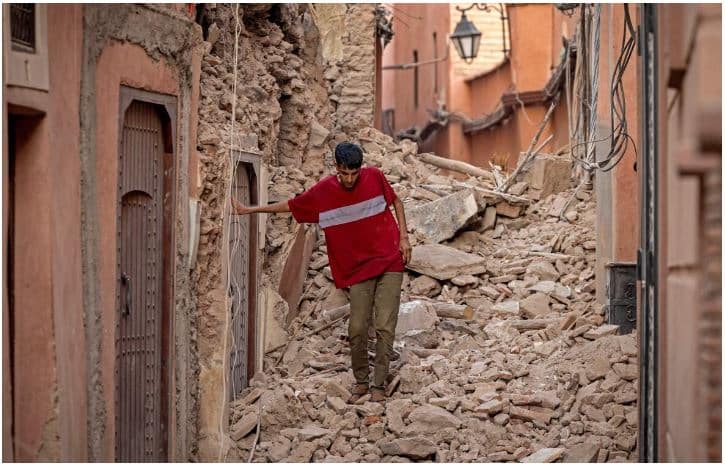

AP — A rare, powerful earthquake struck Morocco late Friday night, killing more than 1,000 people and damaging buildings from villages in the Atlas Mountains to the historic city of Marrakech.
But the full toll was not known as rescuers struggled to get through boulder-strewn roads to the remote mountain villages that were hit hardest.
People woken by the quake ran into the streets in terror and disbelief.
State television showed people clustered in the streets of Marrakech late at night, afraid to go back inside buildings that might still be unstable.

The magnitude-6.8 quake was the biggest to hit Morocco in 120 years, toppling buildings and walls in ancient cities made from stone and masonry that was not designed to withstand such shocks.
“The problem is that where destructive earthquakes are rare, buildings are simply not constructed robustly enough to cope with strong ground shaking, so many collapse resulting in high casualties,” said Bill McGuire, professor emeritus of geophysical and climate hazards at University College London.
“I would expect the final death toll to climb into the thousands once more is known. As with any big quake, aftershocks are likely, which will lead to further casualties and hinder search and rescue.”
Famed mosque damaged
In Marrakech, the famous Koutoubia Mosque, built in the 12th century, suffered damage, but the extent was not immediately clear. Its 69-metre minaret is known as the “roof of Marrakech.”
Moroccans also posted videos showing damage to parts of the famous red walls that surround the old city, a UNESCO World Heritage site.
At least 820 people died, mostly in Marrakech and five provinces near the quake’s epicentre, and another 672 people were injured, Morocco’s Interior Ministry reported Saturday morning. Of the injured, the ministry wrote, 205 were seriously hurt.
Rescuers worked through the night, searching for survivors in darkness, dust and rubble.
Abderrahim Ait Daoud, head of the town of Talat N’Yaaqoub, said authorities are working to clear roads in Al Haouz Province to allow passage for ambulances and aid, but said large distances between mountain villages mean it will take time to learn the extent of the damage.
Roads leading to the mountain region around the epicentre were jammed with vehicles and blocked with collapsed rocks, slowing rescue efforts.
World offers help
Later Saturday morning in Marrakech, ambulances and motorcycles whirred by the edge of the old city, where business as usual mostly resumed Saturday morning.
Tourists and passersby navigated roadblocks and snapped photos of sections of the clay ochre wall that had cracked, spilling fragments and dust onto the sidewalk and street.
World leaders offered to send aid or rescue crews as condolences poured in from the G20 summit in India, countries around Europe, the Mideast and beyond.
Turkish President Recep Tayyip Erdoğan, whose country lost tens of thousands of people in a massive earthquake earlier this year, was among those proposing assistance.
France and Germany, with large populations of people with Moroccan origins, also offered to help, and the leaders of both Ukraine and Russia expressed support for Moroccans.
The Moroccan government has not formally asked for help, a step required in order for outside rescue crews to be brought in.
The U.S. Geological Survey (USGS) said the quake had a preliminary magnitude of 6.8 when it hit at 11:11 p.m. local time, with shaking that lasted several seconds. The U.S. agency reported a magnitude-4.9 aftershock hit 19 minutes later.
The epicentre of Friday’s tremor was near the town of Ighil in Al Haouz Province, roughly 70 kilometres south of Marrakech.
Al Haouz is known for scenic villages and valleys tucked in the High Atlas, and villages built into mountainsides.
The USGS said the epicentre was 18 kilometres below the Earth’s surface, while Morocco’s seismic agency put it at 11 kilometres down. Such shallow quakes are more dangerous.
Initial reports suggest damages and deaths were severe throughout the Marrakech-Safi region, which more than 4.5 million people call home, according to state figures.
Earthquakes are relatively rare in North Africa.
In 1960, a magnitude 5.8 tremor struck near the Moroccan city of Agadir and caused thousands of deaths.
The Agadir quake prompted changes in construction rules in Morocco, but many buildings, especially rural homes, are not built to withstand such tremors.
In 2004, a 6.4-magnitude earthquake near the Mediterranean coastal city of Al Hoceima left more than 600 dead.
Friday’s quake was felt as far away as Portugal and Algeria, according to the Portuguese Institute for Sea and Atmosphere and Algeria’s Civil Defense agency, which oversees emergency response.
Advertise with the mоѕt vіѕіtеd nеwѕ ѕіtе іn Antigua!
We offer fully customizable and flexible digital marketing packages.
Contact us at [email protected]














